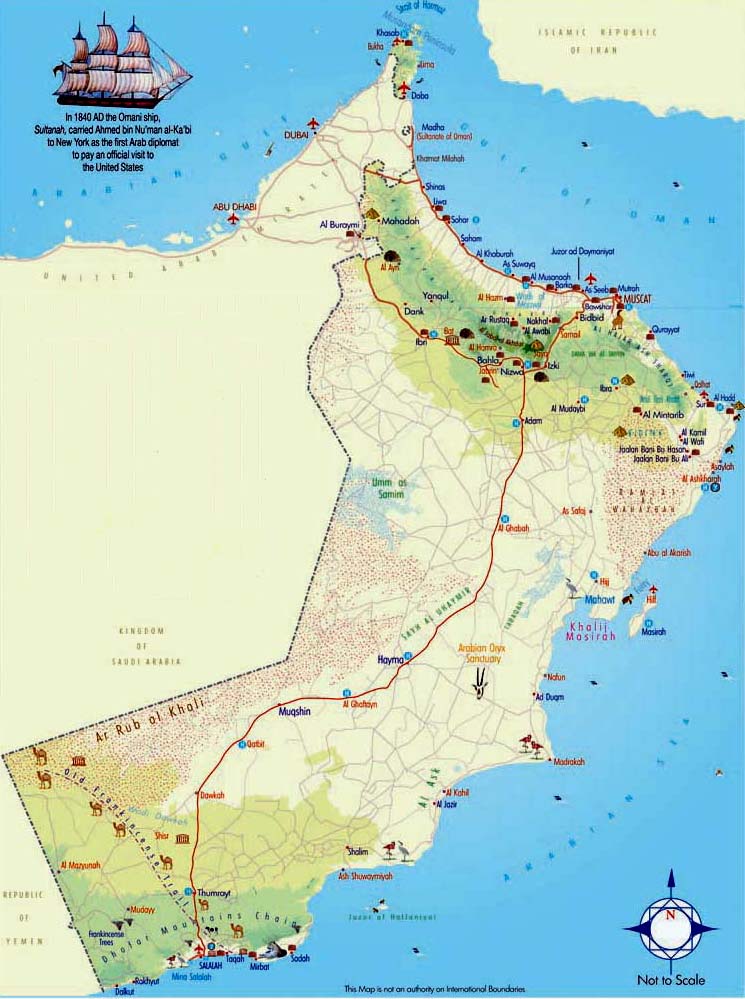-
-
- Oman Map
|
-
-
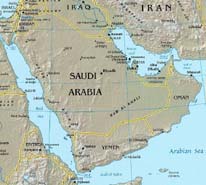
-
- Middle East Map
|
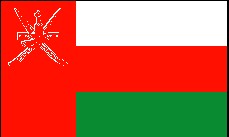
|
-
|
- latest picture: February 24, 2013
|
|
-
-
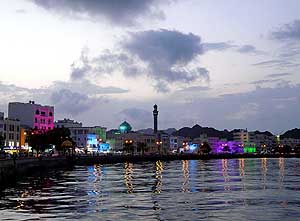
|
-
-
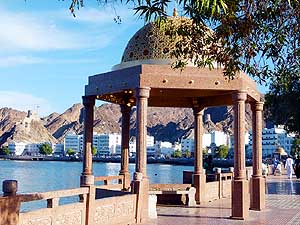
|
-
-
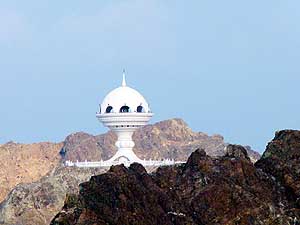
|
- 061
When night is falling, changing
- lights and colors enchant the
- Corniche of Muttrah
|
- 062
The oriental charm is present
- also at the covered benches along
- the Corniche of Muttrah
|
- 063
The white incense burner – called
- Riyam Monument – sitting on a hill at
- Muttrah’s Corniche is a prominent
- landmark. Frankincense has been
- traded on the Arabian Peninsula
- for more than 5’000 years
|
-
|
-
-
-
-
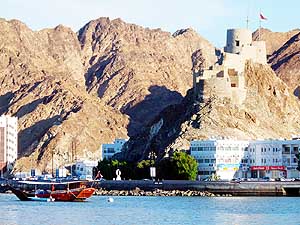
|
-
-
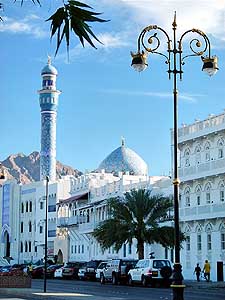
|
-
-
-
-
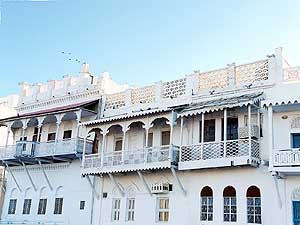
|
- 064
Muttrah Fort: It guards the
- harbor from a rocky outcrop at
- Muttrah’s Corniche
|
- 065
Muttrah is still alive with its
- beautiful colonial architecture,
- dominated by the Al Lawatiya
- mosque, which remembers
- us somehow at Isfahan in Iran
|
- 066
Although Oman was never
- really colonized, the whitewashed
- beautiful merchants houses with its
- elaborated balconies along Muttrah’s
- Corniche originate from those times
|
-
|
-
-
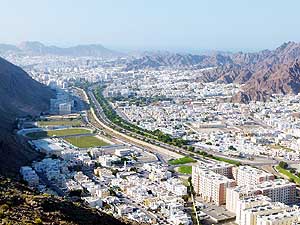
|
-
-
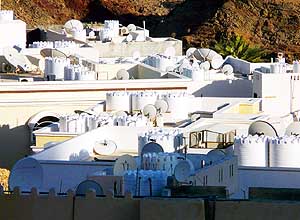
|
-
-
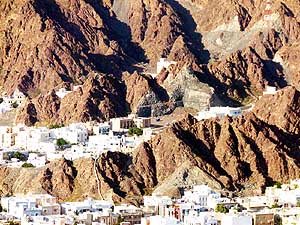
|
- 067
Muscat is expanding more and more
- into the valleys between the rugged mountain
- ranges. In the foreground the suburb of Wadi
- al Kabir followed by Ruwi in the background
|
- 068
Adapted to the Arabian charm:
- The water reservoirs on the rooftops,
- but the satellite dishes seem
- to be inevitable
|
- 069
Free space is becoming increasingly
- smaller around Muscat: Houses squeeze
- already in every somewhat flat mountain spot
|
-
|
-
-
-
-
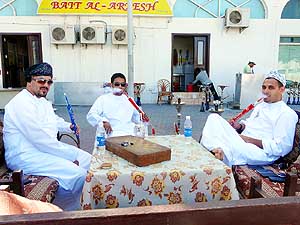
|
-
-
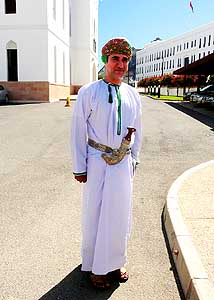
|
-
-
-
-
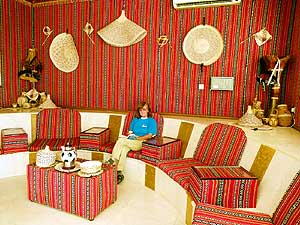
|
- 070
Smoking a “hookah” (water pipe)
- containing shisha with friends is an
- old Arab tradition
|
- 071
An Omani is carrying the silver
- “khanjar” (ceremonial dagger) in his
- belt. Nowadays it is seen only at
- ceremonial occasions
|
- 072
Liliana is relaxing in a typically
- Arabian ambiance (at the
- Green Oasis Hotel, Sohar)
|
-
|
-
-
-
-
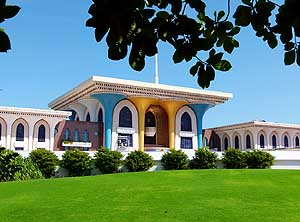
|
-
-
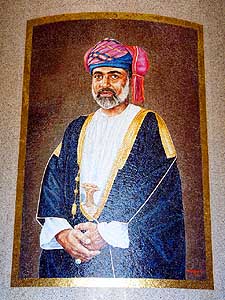
|
-
-
-
-
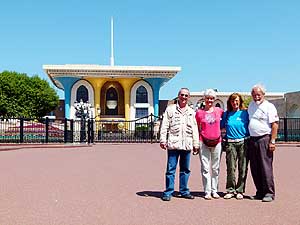
|
- 073
The Sultan’s Al Alam Palace in
- Old Muscat shows little pomp. Only the
- golden and blue pillars give it a touch
- of “royal” uniqueness. It’s mostly used
- for ceremonial occasions
|
- 074
The portrait of Sultan Qaboos
- Bin Said al Said, the Ruler of Oman,
- born 11/18/1940 in Salalah
|
- 075
Capturing a precious moment with
- our Swiss friends Ursula and Marco in
- front of the Sultan’s Palace in Muscat.
- It was a reunion after 15 years
|
-
|
-
-
-
-
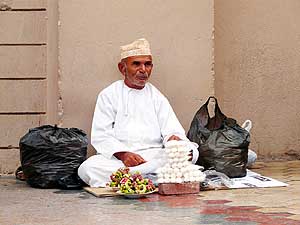
|
-
-
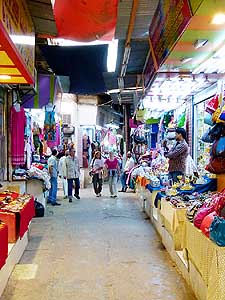
|
-
-
-
-
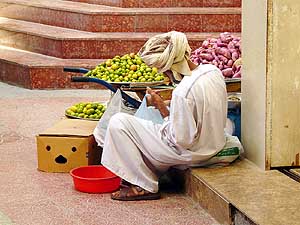
|
- 076
Each shady corner at the lively
- Muttrah Souk is suitable for earning
- a few Rials
|
- 077
With our Swiss friends Ursula and
- Marco we are visiting the Muttrah Souk.
- Interesting are the many busy gold shops.
- Gold is a kind of old-age provision
- for the Omani ladies
|
- 078
Here sweet potatoes,
- lemons and jujube (Ziziphus
- mauritiana) are on sale
|
-
|
-
-
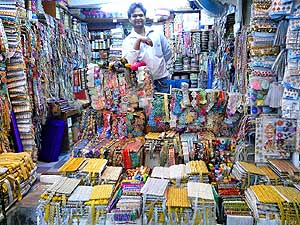
|
-
-
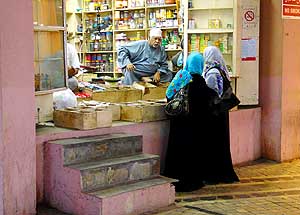
|
-
-
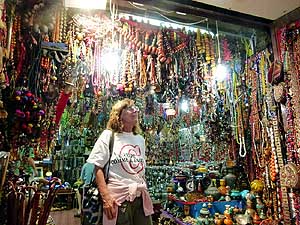
|
- 079
Muttrah’s Souk: A shop filled to
- bursting with a mind blowing display
- of gold, silver and decorative ribbons.
- In the orient they are part of the
- beautiful women’s dresses
|
- 080
In 1994, during our first visit to
- Oman, most of the sellers at Muttrah’s
- Souk were sitting cross-legged among
- their goods in their small boxes. Today,
- this shop is the only nostalgic one we saw
|
- 081
Liliana admires the incredible
- richness of modern jewelry
- in the Muttrah Souk
|
-
|
-
-
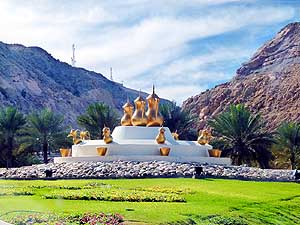
|
-
-
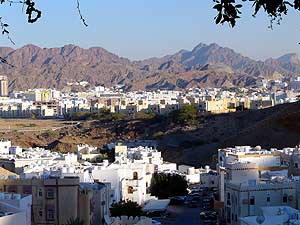
|
-
-
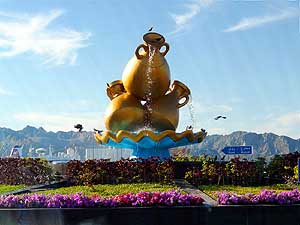
|
- 082
Roundabouts in Oman are always
- built with traditional motifs. Tea pots
- and tea cups are popular; this one at
- the Al Bustan – Qantab intersection
|
- 083
The white-washed sea of houses
- of Muscat (Bayt al-Falaj – Ruwi) is
- contrasting beautifully with the
- dark mountain scenery
|
- 084
The Muttrah Roundabout with
- its splashing water is a bird’s paradise
- in the heat and dryness
|
-
|
-
-
-
-
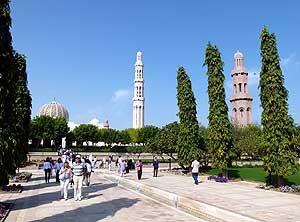
|
-
-
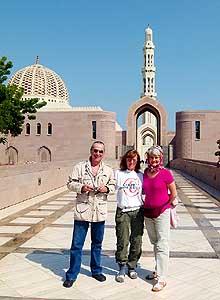
|
-
-
-
-
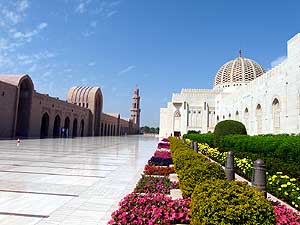
|
- 085
The gold plated dome and the minarets
- of the Sultan Qaboos Grand Mosque come
- into sight. It was one of the biggest mosques
- in the world until it was taken over by the
- Sheik Zayed bin Sultan al Nahyan
- Mosque in Abu Dhabi/UAE (Pic #197)
|
- 086
We capture the moment with
- Ursula, Liliana and Marco in front
- of the Sultan Qaboos Grand Mosque
|
- 087
Lovely flower beds adorn the alley
- to the Sultan Qaboos Grand Mosque
|
-
|
-
-
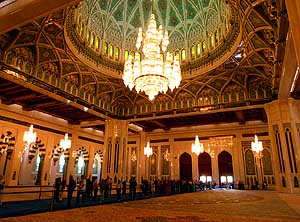
|
-
-
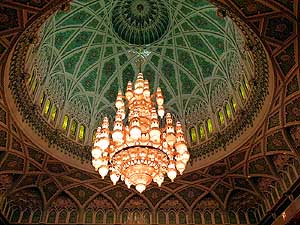
|
-
-
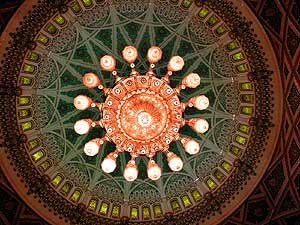
|
- 088
The richness in motifs and craftsmanship
- in the main prayer hall of the Sultan Qaboos
- Mosque is just breathtaking. Alone the
- Persian carpet weaved by 600 women
- during four years, measures 230 by 197 ft.
- (45’208 sq.ft.). The biggest (60’601 sq.ft.) is again in the Sheik Zayed bin
Sultan al Nahyan Mosque in Abu Dhabi/UAE (Pic #204)
|
- 089
The ceiling with the chandelier
- is another masterpiece of craftsmanship.
- It is 46 ft. tall and therefore 3ft. smaller
- than the one at the Sheik Zayed bin Sultan
- al Nahyan Mosque in Abu Dhabi/UAE
|
- 090
The chandelier, photographed
- from below. Diameter 26¼ ft.; weight
- 8½ metric tons (Sheik Zayed bin Sultan
- al Nahyan Mosque in Abu Dhabi/UAE:
- Diameter 32¾ ft.; weight 9½ metric tons)
- (Pic #203)
|
-
|
-
-
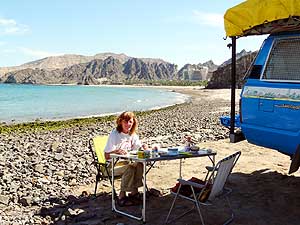
|
-
-
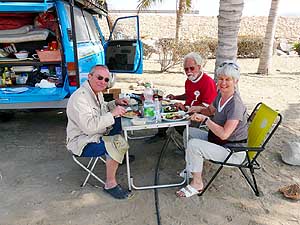
|
-
-
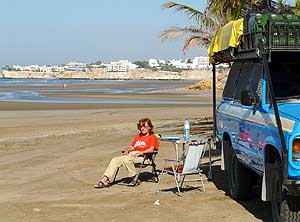
|
- 091
Our first picnic at the sea shore
- with view to the famous Al Bustan
- Palace Hotel, which belongs to
- the Ritz-Carlton chain
|
- 092
Emil is enjoying his birthday
- meal on February 24, 2013, at the
- Qurum Beach in Muscat together
- with our friends Ursula and Marco
|
- 093
A moment of tranquility:
- Liliana at the Qurum Beach in Muscat
|
-
|
-
-
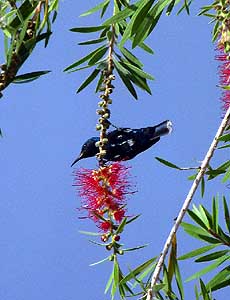
|
-
-
-
-
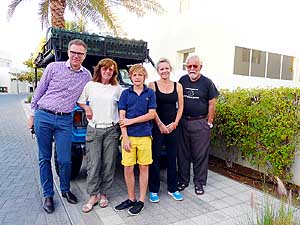
|
-
-
-
-
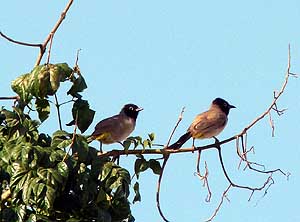
|
- 094
A Palestine Sunbird (Cinnyris oseus)
- is feeding on a crimson bottlebrush flower
- (Callistemon citrinus) in the garden of our
- Swiss hosts Lara, Jonas and Hendrik in “The
- Wave“ compound near Seeb west of Muscat
|
- 095
Our hosts Lara, Jonas and Hendrik
- in front of their villa in “The Wave“
- compound near Seeb west of Muscat,
- where we had a wonderful relaxed time …..
|
- 096
..... and often enjoyed the visiting
- birds in their garden: two yellow-vented
- bulbul (Pycnonotus xanthopygos)
|
-
|
-
-
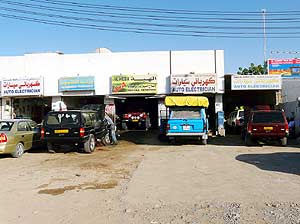
|
-
-
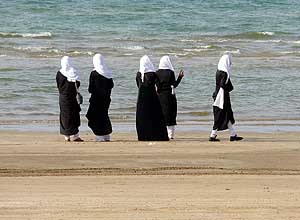
|
-
-
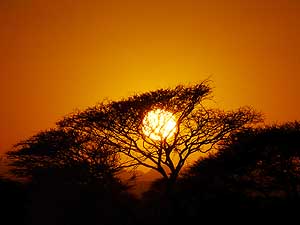
|
- 097
Can we trust this electrical workshop
- with the repair of our lighting system? We
- are lucky! After an hour all the lights work
- somehow again – at least temporarily. Cost
- US$5! But one day the switch assembly
- at the steering wheel has to be replaced
|
- 098
A group of students is enjoying
- themselves over lunch time
- at the Qurum Beach
|
- 099
The red fireball of the setting
- sun is disappearing spectacularly behind
- an acacia tree in the Batinah region
|
-
|
-
-
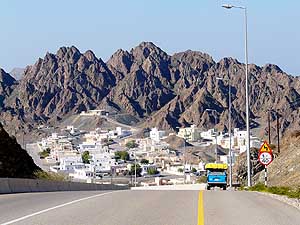
|
-
-
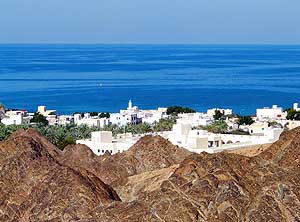
|
-
-
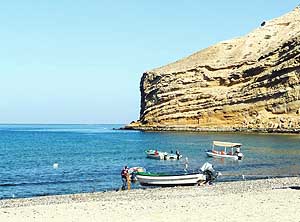
|
- 100
The scenery unfolding below us is
- just stunning: The village of Qantab,
- huddling picturesquely against the foot
- of an impressive mountain scenery …..
|
- 101
..... and stretching further
- to the Gulf of Oman .....
|
- 102
..... where each day at dawn fishing
- boats still sail for their daily catch
|
-
|
-
-
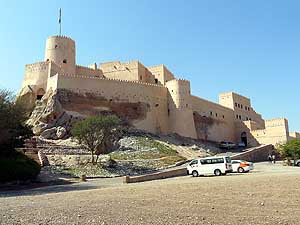
|
-
-
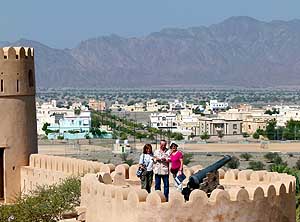
|
-
-
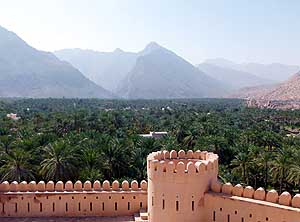
|
- 103
The Nakhal Fort, sitting on a hill,
- is one of the most impressive fortresses
- in Oman. It was built in 1834 on the
- foundation of a pre-Islamic structure
|
- 104
Ursula, Marco and Liliana enjoy
- the view from Nakhal Fort that lies
- about 70 miles from Muscat on the
- northern side of the western Hajar
- range, in all directions …..
|
- 105
..... especially over the Hajar
- Mountains and the lush oasis of date
- palms. A date palm can reach up to
- 200 years of age and deliver 150-180
- pounds of fruits, often even 330 pounds
|
-
|
-
-
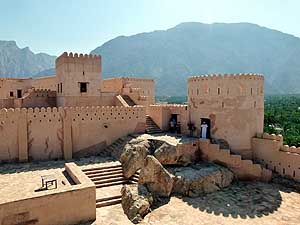
|
-
-
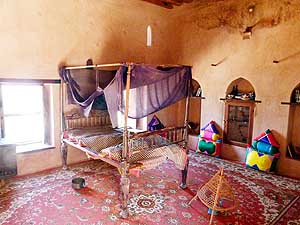
|
-
-
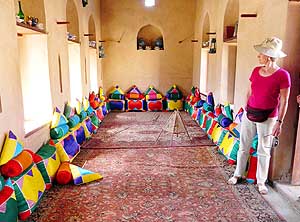
|
- 106
Life within the cool walls and
- towers at Nakhal Fort seemed to have
- been quite comfortable. We visit also
- the living and sleeping quarters, split
- up for female and male residents .....
|
- 107
….. the three-legged structure in
- the female’s quarter has a special purpose:
- Women would stand with their floor-length
- dresses over it so that the smoke of the
- burning frankincense bowl underneath
- is trapped under the dress …..
|
- 108
..... Ursula is looking at the
- women’s quarter with its many
- comfortable cushions. It is easy to
- imagine how social life was taking place
|
-
|
-
-
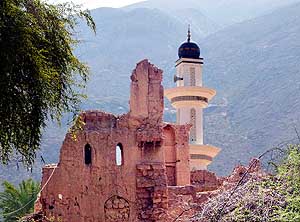
|
-
-
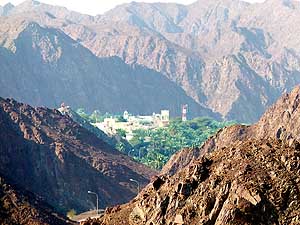
|
-
-
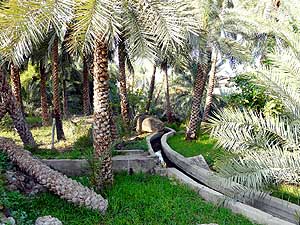
|
- 109
Rustaq: Side by side: Decaying
- old relicts and the present
|
- 110
A typical Omani sight: A small date
- palm oases, surrounded by high mountains:
- Date palms are the livelihood for the people,
- like here in Sibaykha in Wadi Abyad …..
|
- 111
..... fed by Oman’s sophisticated
- water channel system, called “Falaj”.
- The channeled water is first used for
- drinking, then for washing and at last
- it is diverted to irrigate the plantations
|
-
|
-
-
-
-
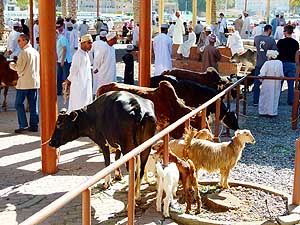
|
-
-
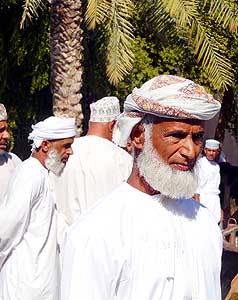
|
-
-
-
-
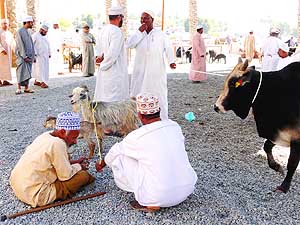
|
- 112
Since decades unchanged is the live-
- stock market in Nizwa. Goats, cows and
- other animals are traded. It is hard bargaining,
- but it is also a welcome event for gossiping .....
|
- 113
….. bearded men in their white
- impeccable “dishdashas” dominate
- the scene …..
|
- 114
….. if no deal is reached, the
- animals will be brought to the market
- again one week later
|
-
|
-
-
-
-
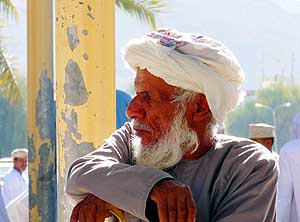
|
-
-
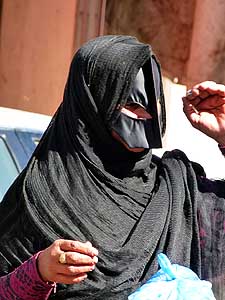
|
-
-
-
-
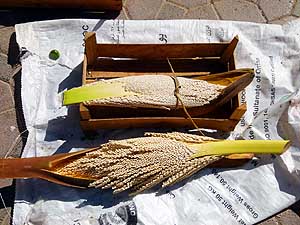
|
- 115
Lifestock market in Nizwa: Is he
- thinking about an accomplished deal or
- merely watching the market life?
|
- 116
Bedouin women have a saying too
- when it comes to the price. Wearing
- the “burka”, the traditional face mask,
- is still very popular among them
|
- 117
Male date palm branches are a trade
- item. A small branch is put manually into
- the female flower on the top of the palm
- tree. “Artificial” fertilization guarantees
- a higher harvest
|
-
|
-
-
-
-
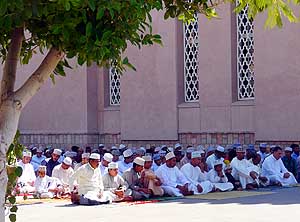
|
-
-
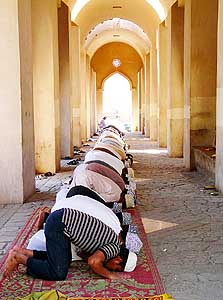
|
-
-
-
-
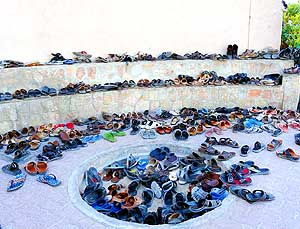
|
- 118
The muezzin has called for the
- important Friday prayer. The Mosque
- adjacent to the Nizwa Fort is jam-
- packet. Men line up with their praying
- mats also in the front court …..
|
- 119
…. they even perform their
- religious rituals at a nearby shady
- arcade, where all businesses
- have shut down .....
|
- 120
..... and at the end each one
- finds and picks his shoes again
- from the untidy heap
|
-
|
-
-
-
-
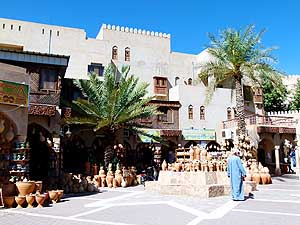
|
-
-
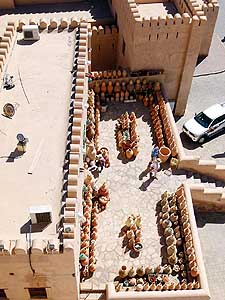
|
-
-
-
-
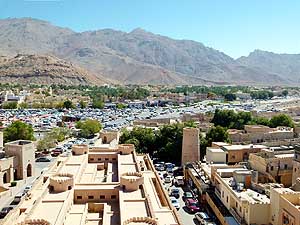
|
- 121
Traditional pottery making is an
- old and continuing tradition in the
- Sultanate. In front of the modern Nizwa
- Souk they pile up for the tourists
- that arrive in great numbers …..
|
- 122
..... and from the height of
- the fortress they look
- like precious miniatures
|
- 123
From the roofs of the Nizwa Fort
- with its famous 130 ft. tall round tower,
- we enjoy a sweeping view. Nizwa is a
- city of history and often also called
- “Pearl of Islam”
|
-
|
-
-
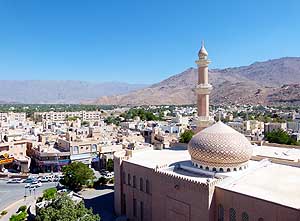
|
-
-
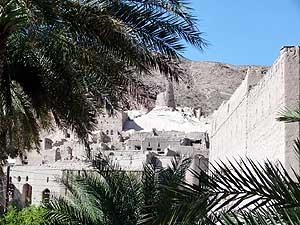
|
-
-
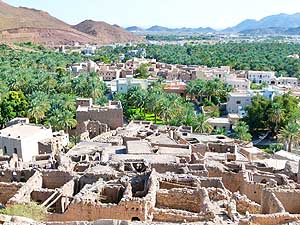
|
- 124
The ornamented dome and the
- minaret of a mosque dominate this
- view over Nizwa from its Fort
|
- 125
The crumbling adobe village of
- the old Birkat al Mawz oases snuggles
- at a mountain slope and blends perfectly
- into its natural surrounding …..
|
- 126
..... from the watchtower the view
- opens to the other side of the valley with
- lush date palm plantations and the foot-
- hills of the Hajar Mountains, from
- where the 500 miles of flat desert
- begins through to the region of Dhofar
|
-
|
-
-
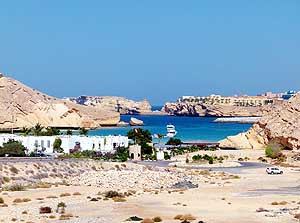
|
-
-
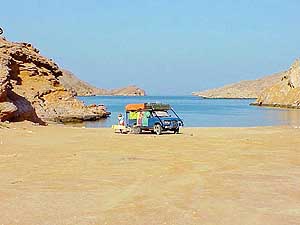
|
-
-
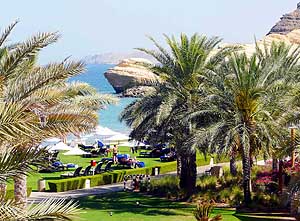
|
- 127
The Oman Dive Center has chosen
- one of the most beautiful bays and reduced
- its charm completely: Bandar Jissah
|
- 128
In 1999 this bay was still beautifully
- untouched. We were alone and enjoyed
- our camping life. It hurts to see how profit
- making is taking over more and more –
- currently all the way down to As Sifah Beach
|
- 129
Now also luxury resorts have
- spread along the more than 30 miles long
- coast southeast of Muscat , like the
- Shangri-La’s Barr Al-Jissah Resort & Spa.
- It is no place anymore for nature lovers
|
-
|
-
- More websites from Oman:
- Oman 1999 - from mid-March to mid-April
1999
- Oman 2013 – Part 1 - February
2013: Musandam Peninsula
- Oman 2013 – Part 3 - March
2013: Sur - East Coast - Island of Masirah - Dhofar
- Oman 2013 – Part 4 - March
2013: Salalah & Surroundings (Dhofar) - Nizwa
- Oman 2013 – Part 5 - March 2013: Western Hajar
Mountains
- (Oman 2013 – Part 6) - April 2013:
Omani Madha Exclave in the UAE
-
- More websites from the Middle East:
- Fairytale Wedding in Dubai - United
Arab Emirates - with our car from February 7th, to May 20th, 1999
- Sharjah + Dubai: United Arab Emirates - without our vehicle from February 19th, to 27th, 2011
- Sharjah/Dubai/1st Traveler's Festival/Emirates
National Auto Museum - UAE with car Nov. 2012 to
Jan. 2013 - part 1
- Liwa - United Arab Emirates with
our car in February 2013 - part 2
- Al Ain, Eastcoast & Ras al Khaima - United
Arab Emirates with our car in April 2013 - part 3
- Welcome to Kuwait on March 3rd, 1996
- Yemen car trip (from Oman to Saudi Arabia)
- from May 16th, to June 15th, 1996
- Sandstorm in Saudi Arabia on February 4th, 1999
- Trip to Dubai in January and February
1999
- Iran 2013 – Part 1: Ferry Port Bandar
Abbas-Shiraz-Persepolis-Pasargad (between
Persepolis and Yazd)
- Iran 2013 – Part 2: Pasargad
(excl.)-Yazd-Esfahan – May 2013
- Iran 2013 – Part 3: Esfahan (excl.)-Chelgerd-Hamadan-Sanandaj-Orumiyeh –
May 2013
- Turkey 2013 –
Eastern Anatatolia - June 2013
- Socotra - without our car from February 9th, to 19th, 2011:
- Part 1: Socotra trip in Yemen (East) –
Hadibo - Dihamri - Arher Beach
- Part 2: Socotra trip in Yemen (South) – Homhil - Aomak Beach - Wadi Daerhu - Dicksam Plateau
- Part 3: Socotra trip in Yemen (West) – Qalansiya - Shouab Beach - Qadama Beach - Momi Plateau - Wadi Ayhaft
|
-
|
